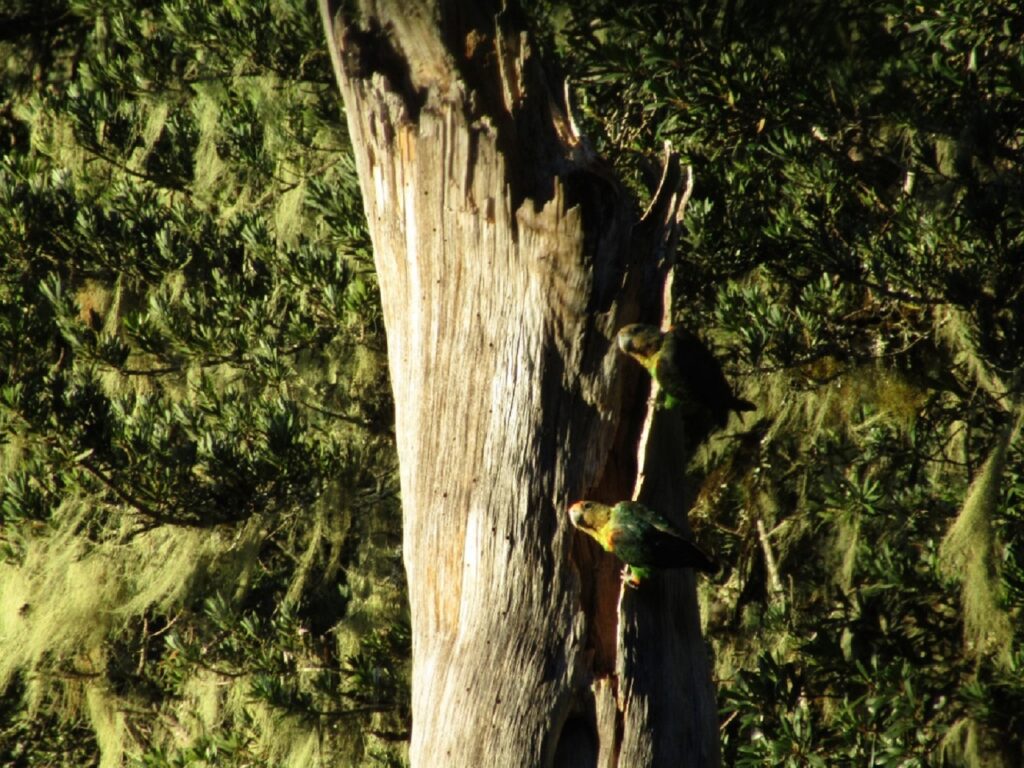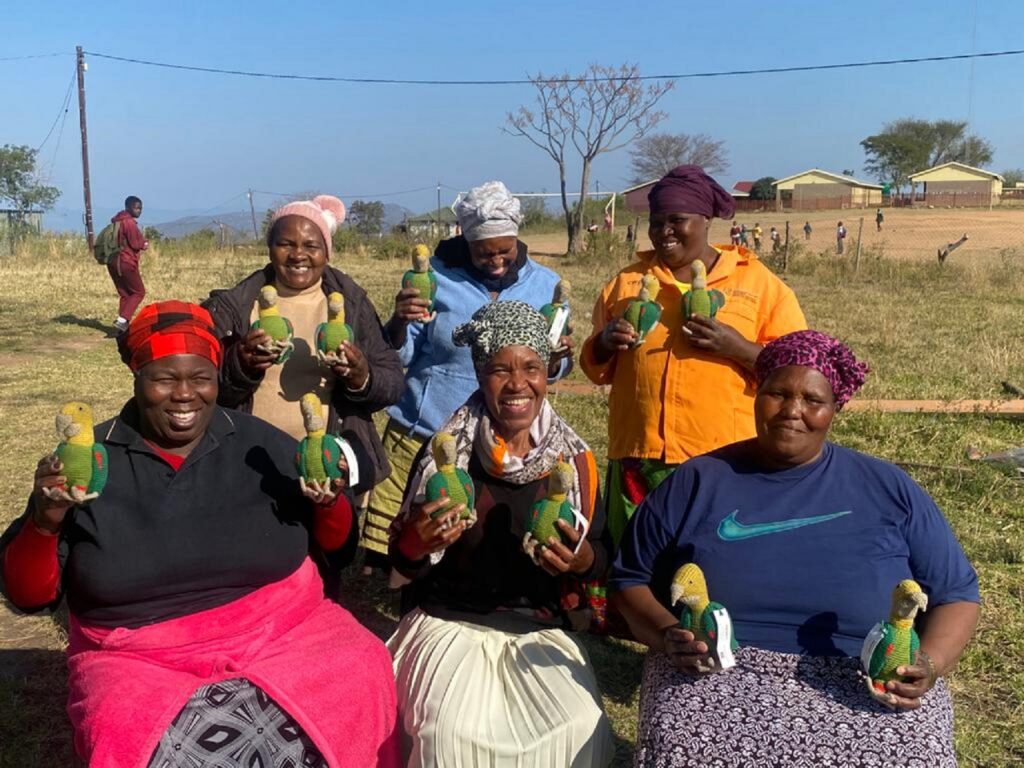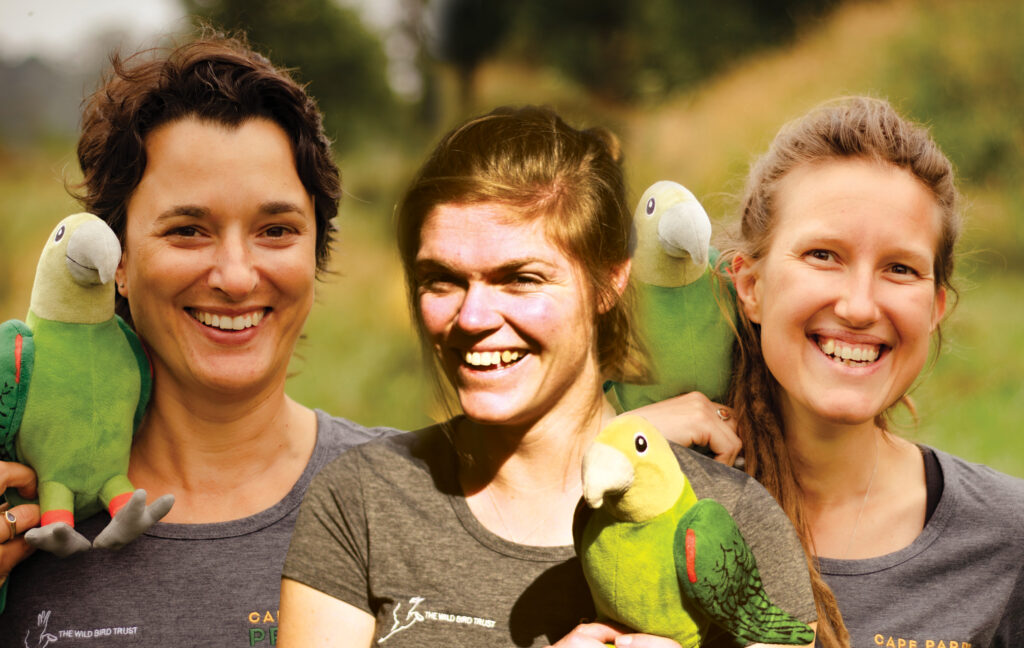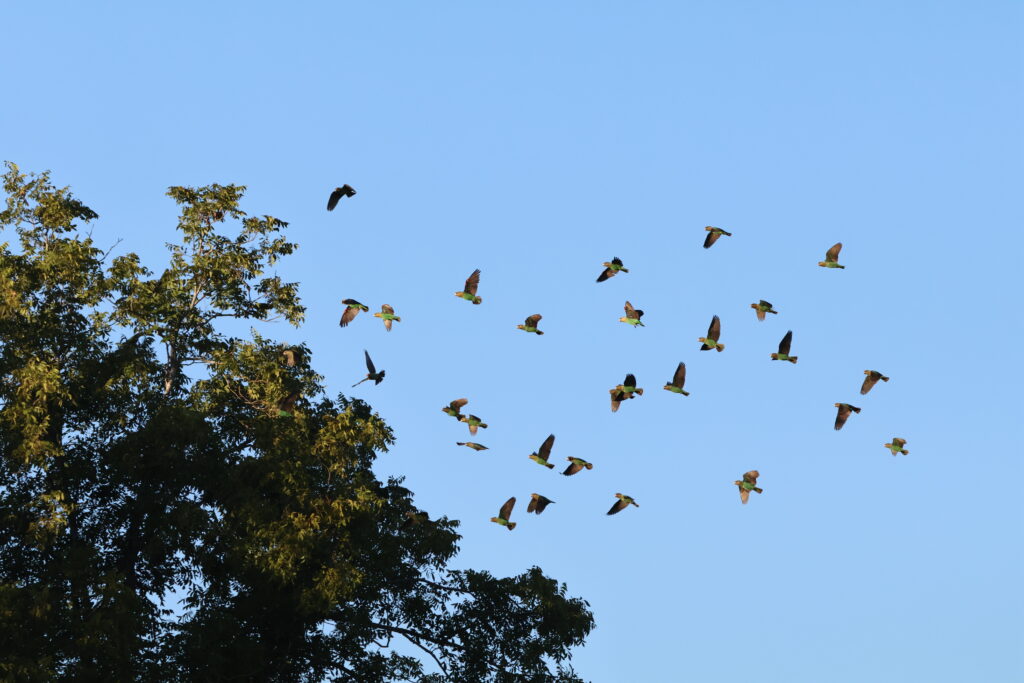The Cape Parrot, the 2023 Bird of the Year, is South Africa’s only endemic parrot. As a result of the degradation of indigenous forests, their natural habitat, which provide food and nesting sites, they have become endangered.
At present, there are fewer than two thousand left in the wild, and farmers, especially pecan farmers, can help to save these parrots.

Cape Parrots are food nomads that move between forest patches depending on food availability and they can fly up to 90 km in a day while foraging. (Source: Cape Parrot Project)
What is the Cape Parrot?
The genus name, Poicephalus, means ‘different head,’ which refers to the different colour of the head to the rest of the body. The species name, robustus, refers to the strong beak used to crack open hard nuts to get to the kernel, such as that of yellowwood trees (Podocarpus spp.), which is prevalent in the Cape Parrot’s habitat.
Common names of the Cape Parrot include Knysna papegaai and woudpapegaai (Afrikaans); isiKwenene (isiZulu); isikhwenene (isiXhosa); hokwe (Setswana).

The Cape Parrot prefers Afromontane Southern Mistbelt forests, which makes up less than 5% of South Africa’s land surface, but they are increasingly making use of commercial crops like pecan nuts. (Source: Cape Parrot Project)
Present distribution
At present, the distribution of the Cape Parrot is naturally restricted to a mosaic of Afrotemperate forests from Hogsback in the Eastern Cape to the Balgowan and Karkloof areas of KwaZulu-Natal. A small, fragmented subpopulation still persists in the Magoebaskloof region of Limpopo Province.

Ladies from Mpakeni community at Ukuthunga Handmade have been trained to crochet Cape Parrots. Front (left to right): Lucy Twala, Paulina Hlatshwayo and Selvy Hlatshwayo Back (left to right): Mavis Thabethe, Sizakele Thabethe and Sibongile Khumbane. (Source: Cape Parrot Project)
The Cape Parrot Project
The Cape Parrot Project, an initiative of the Wild Bird Trust, aims to conserve the Cape Parrot and the indigenous forests through research and habitat restoration efforts. Habitat loss and degradation of mature Afro-temperate forests, on which the Cape Parrot depends for roosting, breeding, and feeding, is one of the primary reasons that it is facing extinction.
“The Cape Parrot serves as an umbrella species for the protection of South Africa’s forests” says Dr Kirsten Wimberger, director of the Cape Parrot Project and trustee of the Wild Bird Trust.
“Deforestation, habitat degradation and illegal logging pose severe threats to these delicate ecosystems. Without immediate action, the Cape Parrot and its habitat face an uncertain future.”

The public can purchase the crocheted parrots from the Wild Bird Trust e-store and proceeds from the sale will not only help the ladies who made them to put tfood on the table, but also to conserve the Cape Parrot.(Source: Cape Parrot Project)
Hogsback, Eastern Cape
Dr Steve Boyes founded the Wild Bird Trust in the Hogsback in 2009. His primary objective was keeping birds safe in the wild by securing critical habitat for the benefit of ecosystems, wildlife, and people in perpetuity.
The initial project was the Cape Parrot Project, based in Hogsback due to the largest population of Cape Parrots being in the Amatole region, where Dr Boyes lived while he undertook his research on these parrots.
The Project partnered with local communities in and around Hogsback to create a Green Economy project, which at present provides work for about eighty people.

Community members from Hogsback in the Eastern Cape work in a yellowwood nursery. (Source: Cape Parrot Project)
This Project sources funding to build community nurseries where the members, who are mostly women, receive training and skills development to germinate and grow indigenous seedlings.
The Project purchase these seedlings for restoring mainly state forests. To date, more than 50 000 trees have been planted and more than two hundred hectares of forest have been restored.
The focus of the MyForest Campaign is on restoring a further 15 ha of critical Cape parrot habitat. This campaign is aimed at getting companies involved in the project.

Community members from Hogssback in the Eastern Cape help to plant trees in an indigenous forest. (Source: Cape Parrot Project)
Ukuthunga Handmade, White River, Mpumalanga
The Cape Parrot Project has also joined forces with Ukuthunga Handmade, a self-sustaining non-profit community-based organisation that makes crocheted toys and home decor items in Msholozi near White River in Mpumalanga.
Ukuthunga employs about sixty women from the various communities in Mpumalanga who joined to gain new skills. The crocheted male and female parrots they crochet are sold to the public, thereby putting food on the table, but also helping to raise awareness of the plight of the parrot.
The proceeds are also used by CPP for research to fill key knowledge gaps and implement conservation action; as well as supporting community nurseries that grow indigenous tree seedlings, which the Project then buys back. These are planted with communities in degraded forest habitats.
“Each one of the crocheted Cape Parrots are unique, making it a one-of-a-kind crocheted toy. Given that many women exclusively rely on crocheting for an income, we are happy to be partnering with Ukuthunga Handmade because it will enable us to benefit numerous disadvantaged families in various communities.

A Cape parrot peeks out from a nest in a hole in trunk of a yellowwood tree. (Source: Cape Parrot Project)
What can farmers do?
“Any farmer who is also the custodian of wild places and wildlife may consider themselves fortunate,” says Kirsten.
Those farming in or around the Afro-temperate mist belt forests of South Africa may find themselves with the protected yellow wood species and their close companions, the Cape Parrot in their care. These are just two of many vulnerable forest plant and animal species found in this biome.
Farmers who are concerned and interested in maintaining biodiversity and taking care of wildlife can do so in diverse ways:
- Join a conservancy: Consider finding out if you can join a local conservancy or collaborate with local conservation organisations to assist with monitoring, ongoing research, and educational outreach activities.
- Keep it wild: Retain wild areas, particularly those in which endangered and vulnerable species occur. Consult with experts such as the Cape Parrot Project to find out best practice and the needs of the species found in your area.

From left to right: Dr Kirsten Wimberger, project director for the Cape Parrot Project and a trustee for the Wild Bird Trust; Dr Francis Brooke, Cape Parrot Project’s research manager, and Dr Jessica Leaver, Cape Parrot Project’s Landscape Conservation Manager. (Source: Cape Parrot Project)
Calling pecan farmers
Farmers with pecan nut orchards within the distribution range of the Cape Parrots, may already have Cape Parrots in their orchards. “Cape Parrots have been known to enjoy the ‘fast food’ aspect of pecan nut orchards, either for nutritional reasons or also for socialisation.”
But their presence can interfere with production. “If you are farming with crops that Cape Parrots are fond of, particularly pecan nuts, and find that the parrots are impacting your crop production, consider mitigating methods that have worked for others with a similar concern.”
Contact the Cape Parrot Project for ideas how to mitigate the impact on the crop, which will also help them track the parrots’ whereabouts.
A ‘parrot-friendly’ label is being considered for farms that are able to collaborate with parrots in terms of best practice.
Other ideas to assist include:
- Restoring or rehabilitating indigenous areas for Cape Parrots to use.
- Planting additional pecan trees which can make up production to the required level while leaving some for the parrots to feed on, as some farms in the Eastern Cape area have done.
- Consider mitigating losses by investigating tourism opportunities for birders and other wildlife enthusiasts who may be excited to have the rare opportunity to see the flocks of parrots that gather in pecan orchards in season.

A flock of African Parrots take to the air from a pecan orchard. (Source: Dr Francis Brooke.
MyForest Campaign
The MyForest Campaign focuses on forest restoration initiatives, including tree planting, habitat restoration, and community engagement programmes. By investing in these projects, companies can actively contribute to the preservation of the Cape Parrot’s habitat, while fostering sustainable development in communities and aid environmental resilience in South Africa.
“We call upon companies to demonstrate their commitment to the environment by considering signing up as a MyForest partner,” says Susan Wishart, project manager of the Cape Parrot Project.
Contact details
For more information on the Cape Parrot Project: https://www.wildbirdtrust.com/projects/cape-parrot-project
To order crocheted parrots: https://shop.wildbirdtrust.com/
For more information on the Wild Bird Trust, visit www.wildbirdtrust.com or on Facebook and Instagram.
Cape Parrot Sanbi (South African National Biodiversity Institute): https://www.sanbi.org/animal-of-the-week/cape-parrot/









